by Jane Casto, Terra Linda High School Freshman
Carnivorous plants is a term often associated with flies and Venus fly traps. There is much more however, to learn about these organisms, and about their complex functions that allow optimal survival and ideal food supply. Scientists have been unraveling the true genius of these plants for years, and even now, breakthroughs are being made in research. To begin, we answer the question: what is a carnivorous plant?
Carnivorous plants, or insectivorous plants, are plants that have adapted to consuming and digesting insects and other animals. These plants work in a variety of ways based on their species, of which there are 600 known to man. The basic understanding of the makeup of carnivorous plants is uniform throughout the different species. Carnivorous plants have adapted to a low-nutrient environment, making digestion of invertebrates optimal, as it is a low-nutrient energy method of consumption.
the Venus fly trap’s deadly leaves, the vibrant trap ready for action
In the example of a Venus fly trap, this ability to digest small insects and organisms is remarkably dependent on the transfer of electrical signaling. According to ScienceLine, “Each trap is actually a modified leaf: a hinged midriB . . which joins two lobes and secretes a sweet sap to attract insects.” This modified leaf is constant throughout all carnivorous plants, while the sap it produces varies in color, sweetness, and other qualities. Following the example of a Venus fly trap, the sap can attract virtually any small creature, and thus, the Venus fly trap often digests small frogs along with the usual fly. When the actual trap of the Venus fly trap is open, the red belly is exposed for all invertebrates to see. Once the prey has been attracted to the trap, the lips of the trap, or the lobes, close within one tenth of a second! So how does a plant move so quickly?
The answer is within the lobes of the Venus fly trap, where three or more small hairs lie. These hairs act as sensors, and if something brushes against two of these hairs, or brushes against one hair twice, the lobes of the plant will snap shut within 30 seconds of initial contact.
small hairs on specialized leaf, or lobe, of the Venus fly trap.
The science behind the closing of the trap is in the pressure caused by something brushing against the hair. This mechanical energy is translated into electrical energy, causing a small electrical signal. This electrical signal is enough to open pores within the center of the lobe, which allow water flow between the cells on the surface of the lobe. Thus water is transferred from the inner layers of the cells to the outer layer of the cells. During the transfer of water, the pressure within the lobes is drastically changed, causing the lobes to invert. This is how the effect of the Venus fly trap is achieved.
These beautiful and deadly plants have a unique way of maintaining survival, and in turn are incredibly interesting to learn about and study.
More on carnivorous plants and when
insects fall victim to them
during the October 21st seminar,
7:30 – 8:30 P.M.
Terra Linda High School, Room 207
320 Albion Way, San Rafael, CA 94903




